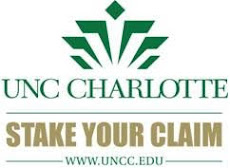Words by
Michael J. Solender
Photos by Jeff Cravotta
Late
last fall, Charlotte-area dance enthusiasts experienced a performance at
Robinson Hall that featured the work of internationally renowned choreographer
Paul Taylor.
As
audience members thrilled to the rebirth of his all but lost work “Tracer,”
performed by the New York City-based Taylor 2 Dance Company, it’s unlikely many
at the sold-out performance realized they were seeing the results of an
extensive faculty research project.
Kim
Jones certainly did. The College of Arts + Architecture associate professor of
dance watched from the wings with a sense of deep satisfaction and accomplishment.
The reemergence of
“Tracer” capped an 18-month reconstruction project led by Jones and represents
an extraordinary collaboration among UNC Charlotte, Paul Taylor American Modern
Dance and community partners in Charlotte.
Seminal
Artist
Leading the movement of postmodern choreographers
during the early ’60s, Taylor and his work demonstrated a creative intensity with
“a direct kinesthetic impact, lifting the spectator to a state resembling a
luminous cloud,” said Dance Magazine in 1963. Taylor is one of the few
remaining third-generation American modern dance masters and considered a
seminal artist of his generation.
In 2015, Jones was approached by Taylor’s company to reconstruct “Tracer.”
Created in 1962 with sets and costumes by artist Robert Rauschenberg, the work
was last performed in 1964 and thought lost to the company with no recorded
footage or accessible notes. The company tapped Jones after her successful reimagination and choreography of the
lost 1935 Martha Graham solo work, “Imperial Gesture.” This
was the first time Taylor authorized an externally led reconstruction of his
work.
Jones’ sleuthing began with a semester-long research
sabbatical where she spent weeks combing archives for clues at the Jerome
Robbins Dance Division of the New York Public Library. Jones conducted dancer interviews and studied
critical reviews, costume design, staging, music and still images. Her most
significant discoveries, however, were made in Taylor’s own archives.
“I
found several reviews, the original Robert Rauschenberg costumes, six
handwritten pages of Paul’s detailed notes, and most amazingly, a reel of the
original James Tenney score in the Taylor archives,” Jones said. “The reel was
given to a sound engineer who was able to extract and enhance a recording with
excellent quality.”
Taylor 2 Residency
on Campus
Jones worked directly with Taylor’s second company, Taylor 2, in New
York. She subsequently fine-tuned the dance with the troupe during its three-week
residency at UNC Charlotte. As part of the residency, the dancers and rehearsal
director also worked directly with students, conducted master classes and held
two public performances.
 |
| Kim Jones (far right) talks with dancers during rehearsal for Paul Taylor lost work, "Tracer." |
“The
project had a great impact on our students,” Jones said. “They were able to
engage directly with professional artists in the studio, working on the nuances
of style and rigor it takes to do the reconstruction and fine-tune details of the
dance.”
Jones
developed two specific curriculum components for student learning as part of
the project. “Our ‘Performance Practicum’ is a course where students learn
choreography,” she said. “Students perform the choreographic works in our biannual
dance concert and learn what is behind producing a great show. With the
‘Tracer’ project, they got the chance to work with the Taylor 2 dancers and
experience what’s involved in staging work at this level.”
Jones
also collaborated with her former professor at Florida State University, Tim
Glenn, on a “Dance Documentation” course developed to take advantage of the
detailed research involved in the reconstructive process. The coursework
focused on student learning techniques and processes to document dance
reconstruction, ranging from interviewing artists to editing raw video footage.
So
significant was the research opportunity, the reconstruction/residency project
was awarded a 2016 Art Works grant from the National Endowment for the Arts.
The project also received an Arts & Science Council grant and a residency
sponsorship from the Wells Fargo Foundation.
“The
project fulfills three mandates of the University,” said Ann Dils, professor
and chair of the Department of Dance at UNC Charlotte. “The project is a
distinct and unique research opportunity; it creates unique curriculum to
benefit students; and it addresses our responsibility to build community
partnerships.”
Partnering with
the Community
In
bringing Taylor’s troupe to Charlotte, the University also facilitated
opportunities for interaction with community partners. In April, Central Piedmont
Community College and Charlotte Ballet are teaming up to bring the Paul Taylor
Dance Company (main troupe) to Charlotte for the first time in 15 years.
The
company will perform as part of the Sensoria Festival of the Arts, with a
program that features "The Rite of Spring,"
performed to live music, using the four-hand piano arrangement of composer Igor
Stravinsky’s original orchestration.
Later this year, UNC Charlotte
students will take “Tracer” into area middle and high schools, reaching out to local
youth and demonstrating the beauty of arts education.
For Paul Taylor American Modern
Dance, the “Tracer” project has been a resounding success. “It is incredibly
important to the art form that we not lose our past,” said John Tomlinson,
executive director of the Paul Taylor Dance Company. “We started a repertory
preservation project in 1992, and this project fits nicely with our ongoing
efforts.”
“Tracer” is part of the Taylor 2
repertory and has already been performed for audiences in Providence, Rhode
Island, and New York City. New York Times dance critic Alastair Macaulay gave
the New York production a positive review, citing Jones as a “dance scholar”
and noting the debut of the reconstructed piece occurred at UNC Charlotte.
“This project is important in many
ways,” Jones said. “It is important to expose the American history of modern
dance. It’s exciting to go behind the works done in the 20th century
and explore how we respond to it. I’m incredibly proud to be a part of that.”
# # #












